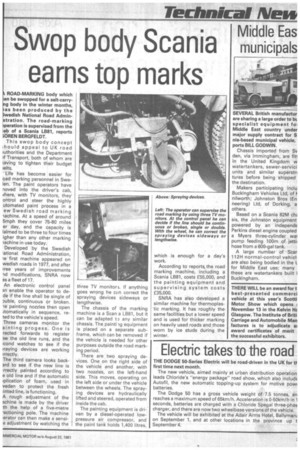Swop body Scania earns top marks
Page 13

If you've noticed an error in this article please click here to report it so we can fix it.
ROAD-MARKING body which an be swopped for a salt-carry g body in the winter months, as been produced by the wedish National Road Admintitration. The road-marking peration is supervised from the :ab of a Scania LB81, reports ;OREN BERGFELDT.
This swop body concept ;hould appeal to UK road luthorities and the Department if Transport, both of whom are laving to tighten their budget ielts.
Life has become easier for oad marking personnel in Swelen. The paint operators have loved into the driver's cab, there, with TV monitors, they ontrol and steer the highly utomated paint process in a ew Swedish road marking iachine. At a speed of around 5mph they cover 75-80 miles er day, and the capacity is laimed to be three to four times igher than any other marking lachine in use today.
Developed by the Swedish ational Road Administration, le first machine appeared on wedish roads in 1977, and after iree years of improvements id modifications, SNRA now as a fleet of 17.
An electronic control panel 3n enable the operator to dede if the line shall be single of 3uble, continuous or broken. le painting nozzles then open itomatically in sequence, reted to the vehicle's speed.
Three cameras monitor the ainting progess. One is rected forwards to register )vv the old line runs, and the !cond watches to see if the 'raying devices are working Irrectly.
The third camera looks backard to see if the new line is Irrectly painted according to e old line and if the automatic plication of foam, used in veden to protect the fresh linted line, is functioning.
A rough adjustment of the achine is made by the driver th the help of a five-metre -ectioning pole. The machine erator can then make a sensie adjustment by watching the
three TV monitors. If anything goes wrong he ciin correct the spraying devices sideways or lengthwise.
The chassis of the marking machine is a Scan a LB81, but it can be adapted to any similar chassis. The painti ig equipment is placed on a separate subframe, which can be removed if the vehicle is needed for other purposes outside the road marking period.
There are two spraying devices. One on the right side of the vehicle and another, with two nozzles, on the left-hand side. This moves, operating on the left side or under the vehicle between the wheels. The spraying devices are hydraulically lifted and steered, operated from inside the cab.
The painting equipment is driven by a diesel-operated lowpressure air compressor, and the paint tank holds 1,400 litres, which is enough for a day's work.
According to reports, the road marking machine, including a Scania LB81, casts £55,000, and the painting equipment and supervising system costs E35,000.
SNRA has also developed a similar machine for thermoplastic marking. It has roughly the same facilities but a lower speed and is used for thicker marking on heavily used roads and those worn by ice studs during the winter.




























































